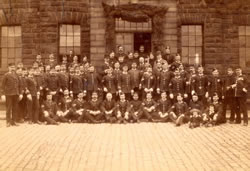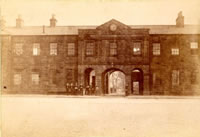Museum of the Manchester Regiment
History
The Regimental Depot - Ladysmith Barracks, Ashton-under-Lyne
The barracks were completed in 1843 at a cost of £42,000 as one of a series of barracks built in Lancashire to house cavalry regiments available to assist the civil power in times of the frequent unrest against organised working class agitation for social and political reforms. The cotton towns of Ashton-under-Lyne, Stalybridge, Dukinfield and Hyde had been important centres of Chartist activity. Work began in 1841, the stone for the buildings coming from a nearby quarry. Many iron rings in the walls of the barracks bore witness to their original purpose for the use of cavalry. Other barracks were built at the same time in Bury and Preston. A Captain Wickham was named as 'Barrack Master' in 1851.
In 1854/5, at the time of the Crimean War, they were occupied by the 6th Royal Lancashire Militia. Following the formation of the Rifle Volunteers in Ashton in 1859 and 1860 the Volunteers regularly drilled at the barracks during the evenings and had their annual inspection on the parade ground. In 1869 it is recorded that the 8 th Foot, later to become the King's ( Liverpool ) Regiment occupied the barracks. In  1873 the barracks were enlarged and that year the 63rd and 96th Regiments were linked together with Headquarters in the Ashton under Lyne barracks. In 1881, when the two were joined together to become the 1st and 2nd Battalions of the Manchester Regiment, the barracks became the Depot and Headquarters of the new Regiment
1873 the barracks were enlarged and that year the 63rd and 96th Regiments were linked together with Headquarters in the Ashton under Lyne barracks. In 1881, when the two were joined together to become the 1st and 2nd Battalions of the Manchester Regiment, the barracks became the Depot and Headquarters of the new Regiment .
.
In 1919 it was apparently impossible to have incandescent gas lighting on the lower floors of the barrack rooms due to the gas mantles being broken by the vibration of the soldiers moving about on the upper floor. The barracks were still lit by gas in 1921. On 31 December 1921 War office approval was given for the Depot Barracks to be known as Ladysmith Barracks in recognition of the siege in the Boer War in which the 1st Battalion had taken part. A new cookhouse and dining room were built in 1937 along with general improvements.
In April 1939, with the threat of war looming, a number of young women living locally volunteered to join 44th (East Lancashire) Company ATS (Auxiliary Territorial Service) and were offered a choice of four categories - clerks, cooks, mess orderlies or storekeepers. Their initial training was held in the 9th Battalion drill hall in Ashton-under-Lyne and later, during August, they moved to Ladysmith Barracks for what was intended as a week of drill under RSM Allen. With the outbreak of war on 3 September they were fully inducted. They all wore the fleur de lys of the Manchester Regiment above their tunic pockets. Being local girls they lived at home and attended the barracks daily, working a seven-day week. On Sundays there was little public transport and those girls living in Hyde had to walk from there to the barracks for first parade, which it is recorded they did in a gang and cheerfully.
The ATS officers initially wore different badges of rank from their male counterparts in the shape of small five pointed stars. A three star officer was called a commandant. The first commandant at Ladysmith Barracks was a Mrs Zimmern described as small and wiry. Her second in command was Mrs Kennedy-Young, wife of a Manchester medical doctor, and the junior officer was twenty-year-old Helen Morton
War broke out on 3rd September 1939 and between the 3rd, 4th and 5th September the barracks became the 'Machine Gun Training Centre, The Manchester Regiment' where intensive training for all battalions was carried out. A hutted camp on the edge of the barracks and across the main Mossley road was built to house the increase in recruits and the nearby Whittakers Mill was also taken over for additional accommodation.
In the spring of 1940 there were so many officers under training that it became necessary to open an overflow mess that was located in several rooms requisitioned at the Warrington Club in Mossley Road, nearly opposite Whittakers Mill. This was used by the officers of D Company commanded by Captain Dick Shepherd although everyone was billeted in private houses. D Company was responsible for the specialist training of signallers and motor transport. The Signals officer was Peter McEachran.
Following the withdrawal from France through Dunkirk in June 1940 a large number of the survivors arrived on a Sunday. Exhausted soldiers, British and French, in ragged uniforms were crowded everywhere - in the gymnasium, on the barrack square, anywhere they could find some rest and comfort.
Lieutenant Colonel F A Levis had assumed command of the MGTC by November 1940. Dances were held in the new Gymnasium on Friday evenings with music provided by the band of the Regiment. Cost of admission two shillings and sixpence for a double ticket and one shilling and sixpence for a single. Proceeds to go to the Regimental Prisoner of War Fund.
Officers on strength at that time were Second Lieutenants C R Abbs, E B Barrett, C H Boone, G F M Chandler, O H Dickenson, F N Furness, E W R Gaff, G R O Handley, J D M Kirkness, J B Lever, L E MacCallum, P McEachran, D B Smith, J E M Waddington.
In 1941, in order to save manpower, the MGTC moved to the Depot of the Cheshire Regiment at The Dale, Chester where it reformed as 24 MGTC. There it acted as a training centre for the four medium machine-gun regiments of the army - the Royal Northumberland Fusiliers, Cheshire Regiment, Middlesex Regiment and Manchester Regiment. By September 1941 only the band of the 2nd Battalion under Bandmaster P L Statham and a small Depot party represented the Regiment in Ashton. In 1942 the barracks, together with the hutted camp and the nearby Whittakers Mill were occupied by 14th Technical Training Centre, Royal Army Ordnance Corps. This was later redesignated 14th Technical Training Centre Royal Electrical Mechanical Engineers, and in November 1944 moved to Aborfield. It was at this time that the Manchester Regiment ATS Auxiliary Unit was broken up and the ATS girls were posted to a number of different locations. It was also at this period the question "When does our own Regiment come back?" was frequently asked by the citizens of Ashton-under-Lyne.
With the end of the war in 1945 the north and south hutted camps outside the barracks became No 7 Military Dispersal Unit whilst Whittakers Mill became No 7 Military Collecting Unit, both dealing with the demobilisation of men leaving the army. They were then taken over by 7 th Heavy Anti-Aircraft Regiment Royal Artillery. In November 1946 the Depot of the Manchester's was transferred to Dunham Park, Altrincham, part of the Stamford Estate that during the war years had been a camp for German prisoners of war. Here the Depot, commanded by Major H R C Green, became a joint unit with the 63rd Primary Training Centre, previously based at The Dale in Chester, and now commanded by Lieutenant Colonel Philip Buchan. Training of recruits for the Manchester 's and other Lancashire Regiments was carried out and the first recruits arrived on 5th December 1946.
In 1949, to the joy of everyone in the Regiment, the Depot was re-established at Ladysmith Barracks where it continued to act as headquarters and training unit for both regular army recruits and the new influx of national service soldiers. In 1958, following the amalgamation of the Manchester Regiment with the King's Regiment, the Regimental Depot was closed.
The barracks were eventually sold to the local hospital authority and then to a local firm of building developers. A housing estate was built on the site of the parade ground, the barrack blocks and all those buildings, which for so many years had reverberated to the noise, and activities of many thousands of young soldiers. Only the imposing entrance archway and the barrack wall facing Mossley Road were left, which later become a registered historical monument.
In 1997 a ceremony was held at the gateway when the Mayor of Tameside unveiled two 'blue plaques', one commemorating Lieutenant W Forshaw VC of the Ashton Territorial Battalion - the 9th Manchester's - and the other commemorating the long association of the Manchester Regiment with the Ladysmith Barracks.

